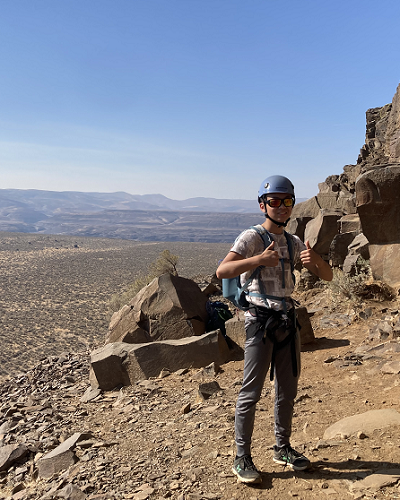Using Design Thinking to Reduce Carbon Emissions

As climate change continues to negatively impact our world, an Upper School class at Overlake is looking at reducing that impact within its sphere of influence. Gerald Blycker’s Design Thinking with Impact class is a semester-long look at using design thinking principles to generate solutions to some of the most challenging problems. For Overlake, the problem the class is looking to solve is reducing the carbon footprint that this school campus emits.
“In selecting a problem for students to work on applying the design thinking process, I really wanted to have an issue that students would be invested in and would also have a big impact on their lives and our community,” explains Blycker. “Many students are worried or anxious about their future because of climate change.”
All semester the students have been interviewing stakeholders at the school, including administrators and board of trustee members to better understand how decisions are made, and funds are allocated each fiscal year, acknowledging that many solutions to reducing Overlake’s carbon emissions cost money. The students learned that the biggest contributors to our carbon footprint is transportation, energy, and food.
“They need to come up with a plan for Overlake to reduce its carbon footprint to zero over the next 15 years. This requires reducing our energy consumption, transitioning away from natural gas heating and installing electric heat pumps,” explains Blycker. “It also requires replacing diesel buses with electric buses. Then, our electricity needs to be produced by renewable energy sources, like the sun using solar panels.”
For their project, the students worked within these project parameters.
“Something that was an ‘a-ha moment’ for me was how much the student voice matters and how teachers and administrators have opinions and how important it is for us to have an open dialogue,” explains Vidhi M. (’25). Vidhi and her teammates presented their findings this week in class with some of the interviewers popping in to hear the findings.
“Before this process it was easy for me to say ‘why isn’t Overlake installing solar panels? Why are we doing electric buses?’” but now I see how many limitations there are and how much work actually has to be done for that, and since Overlake is a not-for-profit, we can’t just be spending money,” observes Sebastian t. (’26)
The goal of the project was to come up with ways that Overlake could drastically reduce, if not eliminate its carbon emissions within 15 years. An ambitious plan, Blycker admits. “Some plans could be implemented in less time, but a 15-year time frame allows large capital expenses to be spread out over more time. Very few companies or organizations have reduced their carbon emissions to zero. Most that are working on that goal simply pay for carbon offsets to counter their emissions, instead of actually eliminating fossil fuels and generating their own renewable energy.”
And while these plans may seem ambitious and unreachable, if there’s a collective will from both the adults and the students at Overlake, real change could occur.
“I personally think it will,” says Sebastian. “Because when I was interviewing our clients, being Krishna Davda, Marshall McCurties, Mike Davidson, and a board member, I kind of saw their almost passion for sustainability. And I think our new head of school, Gretchen Warner, it is inspiring to see her passion for sustainability and her want to have this dream of being net zero.”
Blycker is hoping the momentum started with this project carries across our community to begin change. “I am sharing these plans with administrators and board members. My hope is that Overlake will make a commitment to reducing our carbon footprint and these plans can be used as a blueprint. If Overlake is to live up to our mission, vision, and values, we need to take action to solve the climate crisis.”



